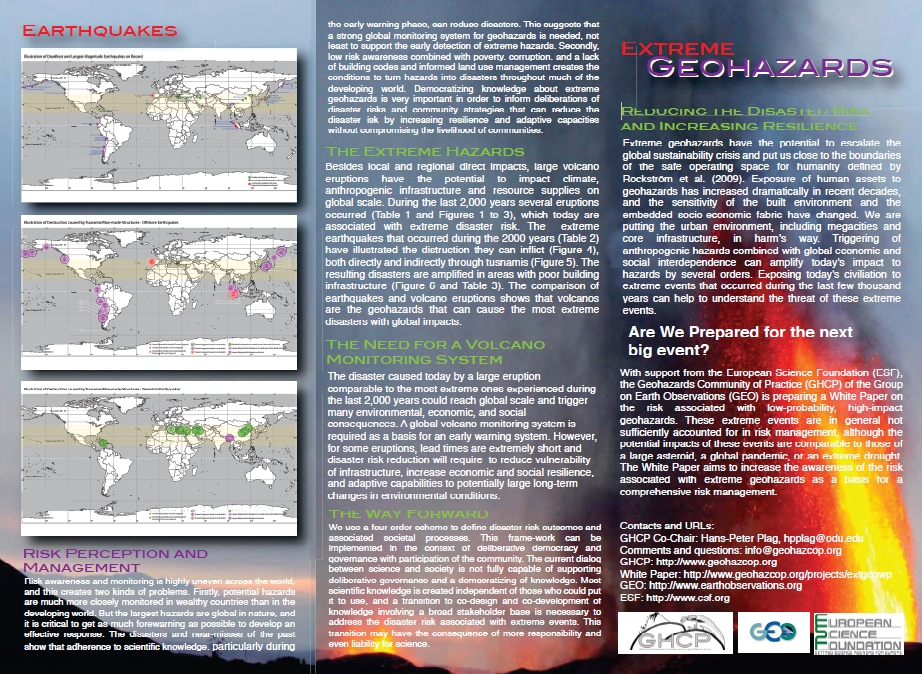 |
The Community Science Position Paper on extreme geohazards has been published. The paper was launched in a splinter meeting at the EGU Assembly in Vienna on April 14, 2015. For more details see the announcement.
Download the PDF file here ...
The ESF press release distributed on April 13, 2015 resulted in numerous articles in the press in different countries. Examples include:
|
 |
At the IDRC 2014, Davos, Switzerland, August 25-28, 2014, a poster on the white paper was presented. A special session discussed various aspects addressed by the White Paper. |

 |
A leafet summarizing the White Paper on extreme geohazards was distributed at the AGU Science Policy Conference in Washington, D.C., June 25-26, 2013. The leaflet emphasizes the extreme disaster risk associated with large volcanic eruptions, which could worsen the sustainability crisis and challenge our global civilization to its core. At the AGU conference, a session on mega disasters considered large floods, solar storms, and asteroids as potential causes for mega disasters, but did not mention the very real threat from large volcanic eruptions. Read the leaflet (77 MB) ... |
 |
The GHCP presented a poster introducing the White Paper on extreme geohazards at the EGU Assembly in Vienna. Read the poster (16 MB) ... |
 |
The GHCP participated in the GEOSS Exhibition co-located with the GEO Plenary and the Ministerial Summit on Earth Observations, held November 1-5, 2010 in Beijing, China. The GHCP presented a poster and was also featured in the COP Brochure.
|
Geohazards: A challenge to Society
In many regions, geohazards are a major threat to society, costing lives, disrupting infrastructure and destroying livelihoods. Understanding the associated processes and gaining a comprehensive knowledge of the location and behaviour of these hazards is pivotal for risk assessment, hazard mitigation and adaptation, reduction of vulnerability and preparedness. The importance of observing and understanding geohazards to the GEO Disasters Societal Benefit Area (SBA), in particular, in building a successful Global Earth Observation System of Systems (GEOSS) is clear. Communities of Practice support GEO in its goal to provide the observations required to support informed decisions in the nine SBAs. In particular, Communities of Practice are a key mechanism for the linkage of GEO to the users of products and services provided by the GEOSS.
The Geohazards Community of Practice for GEO
Over the past few years, initial steps have been taken by members of the former IGOS Geohazards Theme Team to make progress towards a Geohazards Community of Practice (GHCP) for GEO. This has been seen in successful initiatives like Super Sites and through a number of GEO Tasks, in the Disasters SBA, in other SBAs and in cross-cutting tasks like the Global Datasets Task. In order to support and build on this progress, a comprehensive review of the current situation and the development of strategies for the next five years is timely. Therefore, together with GEO and UNESCO, the GHCP organized its 1st Workshop on January 18-21, 2010 in Paris (see Workshop Page ...). This Workshop was of interest to the entire GEO and wider geohazards community; space agencies, geological surveys, end users such as civil protection agencies, the key observing systems (geodetic, seismic, magnetic) and the international networks for the major hazards addressed by the GCoP (earthquakes, volcanoes, landslides, subsidence).
Our Strategic Target
By 2020 put in place all building blocks for comprehensive monitoring of geohazards and the provision of timely information on spatio-temporal characteristics, risks, and occurrence of geohazards, in support of all phases of the risk management cycle (mitigation and preparedness, early warning, response, and recovery), and as a basis for increased resilience and disaster reduction.
This will be achieved
by developing a global network of very few carefully selected core sites. These core sites will provide focal points for a large geographical region, where all building blocks of a value chain from observations to end users can be linked together and applied to the phases of the risk management cycle relevant for this region. Thus, these core sites will demonstrate the concept, enable scientific studies and technological developments, provide for capacity building, and inform policy and decision making in the region.
|
For selected information on recent extreme events, see here ...
The Declaration on Extreme Geohazards ...
The Draft Roadmap of the GHCP ...

The IGOS Geohazards Theme report is the basic reference document on which the GHCP builts. This report comprehensively addresses the observational requirements resulting from key applications concerning the societal impact of geohazards, such as the mapping of geohazards, the assessment of risks resulting from geohazards, raising the awareness, and monitoring hazardous areas and providing timely warnings.
Available locally.
|